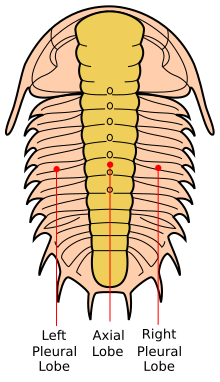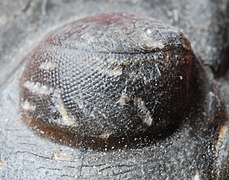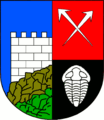Trilobites
| Trilobites | ||||||||||||
|---|---|---|---|---|---|---|---|---|---|---|---|---|
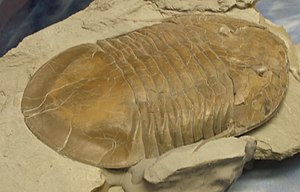
Isotelus brachycephalus |
||||||||||||
| Temporal occurrence | ||||||||||||
| Cambrian to Permian | ||||||||||||
| 521 to 251 million years | ||||||||||||
| Locations | ||||||||||||
|
||||||||||||
| Systematics | ||||||||||||
|
||||||||||||
| Scientific name | ||||||||||||
| Trilobita | ||||||||||||
| Walch , 1771 |
The trilobites (Trilobita, "Dreilapper", from ancient Greek τρία tria "three" and λοβός lobós "lobes") are an extinct class of sea-dwelling arthropods (Arthropoda).
The trilobites existed for almost the entire period of the Paleozoic (Earth Age), from the 2nd series of the Cambrian (beginning 521 million years ago) to the mass extinction at the end of the Permian about 251 million years ago. Their exoskeletons, reinforced with calcite (calcium carbonate) to form a shell, have been preserved in large numbers as fossils and thus make it possible to reconstruct the evolution and the wealth of shapes of the numerous species. This, in connection with their stratification and wide geographic extent, makes trilobites important key fossils for the Paleozoic, especially in the Cambrian.
The trilobites were among the first arthropods , an animal tribe with an exoskeleton , an articulated body and many coordinated legs. Their tracks have also been found many times as Ichnofossils , these trace fossils are called Rusophycus and Cruziana .
The extinct class of the Trilobita consists of nine recognized orders , over 150 families , over 5000 genera, and more than 15,000 described species . More species are found and described every year. Their diversity makes the trilobites the most divergent group of all extinct creatures . The largest known trilobite with a length of more than 70 cm is Isotelus rex from the Upper Ordovician of North America.
Naming
The term "trilobite" was introduced by Johann Ernst Immanuel Walch in 1771 , but it was not until the beginning of the 19th century that the name became established in science .
anatomy
The trilobites ("three lobes ", formerly also misleadingly called "three-lobed crabs") always consist of three sagittal lobes ("lobes"), which give these animals their name: the spindle lobe and the two pleural lobes on the left and right side. The trilobites are also divided transversely into three members ( tagmata ): head shield ( cephalon ), thorax and tail shield ( pygidium ).
Spindle lobe
The middle lobe is called the spindle lobe or axis lobe . The piece of the spindle lobe on the head shield ( cephalon ) is called the frontal lobe ( glabella ) and often consists of several transverse and often fused lobes. There are incomplete or completely dividing furrows between the praises. The front part of the glabella is called the anteroglabella and the back part is called the posteroglabella . On the left and right of the posteroglabella there are elevations in some species, which are called basal lobes (for example in Agnostida ).
The term spindle (or axis ) is ambiguous. Sometimes this term only refers to the parts on the thorax, occasionally the parts on the thorax and tail shield ( pygidium ) are described with it. The spindle is divided into different spindle rings (also called axial rings ). The furrows between the rings are called spindle furrows ( axial furrows ).
The transverse lobe in the transition from the glabella to the rachis is called the neck ring or occipital ring . It is pronounced in most species and sometimes has a pointed process ( tubercle ), which is called the occipital tubercle or neck nodule .
Rhachis comes from the Greek and actually means "spinal cord". The rachis is the part of the spindle on the tail shield ( pygidium ) and is divided into different rachis rings . The furrows between the rings arecalled rachis furrows.
Pleural lobe
The left and right sides of the trilobite are called the pleural lobe . They go from the tip of the cephalon laterally over the free cheeks, where compound eyes are often located, laterally over the thorax and laterally to the tip of the pygidium. The pleural lobes are separated in some types by furrows on the head and tail shields. These furrows exist between the hem and the top of the spindle lobe. This fringe furrow is called the median embossed labellar furrow on the head shield and the median postaxial furrow on the tail shield . In some species these furrows have grown together and can no longer be recognized.
The right and left part of a segment (also splint ) of the thorax is called the pleuron or pleure . The ends of a pleuron can be rounded or pointed depending on the type. Furrows on the pleurs are called pleural furrows .
Head shield (cephalon)
On the ventral side of the head shield there is a rostral plate in some species , which is also called rostrum (Latin for "beak"). It can serve as an attachment for the hypostome . The hypostome is a plate on the underside of the cephalon in trilobites. It was probably part of the oral apparatus. The shape and the positioning of the hypostome are essential features in the systematic classification of the trilobite species.
- Conterminant positioning: In the so-called conterminant positioning, the hypostome is attached to the rostral plate. The front of the glabella on top is flush with the front of the hypostome.
- Natant positioning: In the so-called natant ("floating") positioning, the hypostome lies within the underside of the cephalon and is therefore no longer connected to the rostral plate. With this positioning, too, the glabella front is flush with the hypostome front.
- Independent positioning: The hypostome is attached to the doublets , but is positioned independently of the glabella. The glabella is usually longer and thus overlaps the hypostome.
The trilobites only had a pair of specialized head appendages, these were designed as long articulated antennas and probably served as sensory organs. Only in the order Agnostida were shorter, heavily bristled antennae that could have been used for food intake (among other things, the inclusion of the Agnostida in the trilobites is doubted by some researchers). The remaining limbs of the head segments, which were covered together by the head shield, correspond completely to the split legs of the trunk segments. It is therefore assumed that the legs of the trilobites served unspecialized both for locomotion and for feeding at the same time. Corresponding conditions exist in many crustaceans living today , for example in most leaf crabs.
Face seam
Explanation based on Lehmann , 2014
Another diagnostically important feature in the area of the cephalon is the facial suture ( sutura facialis ). The facial seam is a predetermined breaking point in the exoskeleton of the cephalon, which enables the trilobite to crawl out of the old carapace when molting. The head shield breaks down into the cranidium, ie the glabella plus the fixigenae ( Sg. Fixigena; fixed cheek or fixed cheek), and the two librigenae (Sg. Librigena; free cheek or free cheek). Depending on the position and course of the facial seam, a distinction is made between several basic types:
- Protoparic or hypoparic facial suture: In this case, the skin suture does not run across the cheeks, but along the entire length of the outer edge of the cephalon. During the moulting process, only the doublure (hem edge, that part of the armor that is bent over towards the unarmored belly side) of the head shield is cut off. Free cheeks are not trained. This feature occurs particularly frequently in primeval trilobites, e.g. B. within the order of the Agnostida , (protoparous), but also secondary to some highly specialized forms from the order of the Harpetida (hypoparous).
- Propar facial suture: A facial suture is referred to as propar, which only runs along the outer edge in the foremost area of the cephalon and then crosses over to the top of the head shield, from there further in the direction of the ocular hillock (palpebral lobe) and moves along the inside of the compound eyes finally returns to the outer edge of the cephalon before the cheek corner or the cheek sting.
- Gonatopic facial suture: The basic course of the gonatopic facial suture is similar. However, the skin seam does not end at the outer edge of the head shield, but directly in the corner of the cheek or at the tip of the cheek spine.
- Opisthopic face suture: An opisthopic face suture differs from proparous and gonatopic face sutures in that the skin suture ends only after the corner of the cheek or the cheek spine, i.e. not at the outer edge but at the rear edge of the head shield.
- Metaparous face seam: A metaparous face seam is fundamentally different from the other types. Here the skinning seam begins at the rear edge of the head shield, runs in the direction of the ocular hillock and back again to an exit point which is also located on the rear edge of the head shield.
eyes
Not all trilobite species have eyes formed. If there are eyes, they are compound eyes , which, like the exoskeleton, are made of calcite . Thus these eyes are not directly comparable to those of today's arthropods. Most researchers assume, however, that they are homologous to the compound eyes of the other arthropods. Since calcite is an inorganic material, the compound eyes in the fossilized exuvia and individuals have been preserved very well as they were not decomposed by microorganisms .
The eyes come in three shapes: holochroal , schizochroal, or abathochroal compound eyes.
- In the holochroal compound eyes, the individual eyes are closely lined up without a sclera in between. (Sclera is additional exoskeleton material which has a similar function as the sclera has the mammalian eye.) The cornea ( cornea ) covers all individual eyes simultaneously. There are up to 15,000 individual eyes.
- In the schizochroal compound eyes, the individual eyes are separated by a pronounced thick sclera that encompasses the eyes. Each individual eye has its own cornea, which is also captured by the sclera and extends deeper into the inner exoskeleton. With this type of compound eye, there are only up to 700 individual eyes.
- A sclera also occurs in the abathochroal compound eyes. This is, however, a lot thinner than the schizochroal compound eyes and at most just as thick as the individual eyes. As with the schizochroal eyes, each individual eye has its own cornea. This ends at the beginning of the sclera.
Holochroal compound eyes in Paralejurus
Schizochroal compound eyes in Erbenochile erbeni
thorax
The thorax is made up of segments. The number of segments and the shape is systematically relevant. Small agnostid trilobites have only two or three segments. Larger trilobite species contain up to 18 pieces. In animals with a special way of life, the segments can also take on different shapes. For example, they have prickly extensions, presumably to protect themselves from predators. On the other hand, as with the species of Paralejurus , they can be curved to facilitate what is supposed to be digging.
Split legs
Since only the upper side of the trilobites was hard-shelled and calcified, fossils that enclose the soft-skinned underside with the legs are very rare and have only been found in a few fossil sites worldwide. Trilobites had so-called two-branched split legs . The first branch is called the web or gill bone (exopodite) and was used for swimming movement in the sea. The second branch is called running leg (endopodite) and was used for walking on the seabed.
- The leg consisted of the Coxa and seven other links. The coxa was attached to the precoxa. The limbs could have additional spines.
- The swimming leg was attached to the precoxa and consisted of two or more limbs, depending on the species. The last link or several of these links had fan-like extensions that made it possible to paddle in the water.
development
Trilobites developed over a multitude of stages in which segments were inserted into a growth zone immediately before the rear end with each moult (anamorphosis). Most trilobite species had a fixed number of segments as adults, but in some very leggy taxa the insertion of new legged segments evidently progressed even after sexual maturity until death. The development of the trilobites is very well known in many species through numerous finds of animals of different sizes that can be arranged in series, and through finds of exuvia (shells that remain after a molt). As a rule, the larval stages also had a calcified dorsal cover (exception in the case of the agnostids and possibly other groups).
The first larval stage of the trilobites is called Protaspis, it consisted of four limb-bearing head somites, a short head shield and a bud-like structure of the thorax. Later stages reveal two regions (tagma), namely head and torso, they are called meraspis. A region at the rear end could develop a transitory tail shield (pygidium). New segments emerged near its rear end, migrated through the structure as the skin was moulted and were tied off at the front end to form free trunk segments. Eventually a stage was reached that no longer formed new segments, it is called holaspis. Animals in the Holaspis stage have shed their skin and were able to gain in size, sometimes considerably. When exactly the animals reached sexual maturity, the fossil material cannot tell. As a rule, however, fully grown specimens with a clearly defined number of segments, shape and size are clearly recognizable.
Way of life
Trilobites were usually inhabitants of the sea floor ( benthos ). Most fossils are from coastal ( littoral ) habitats, e.g. Sometimes also from middle sea depths ( shelf areas ). Obviously there were no deep-sea forms. The existence of swimming ( pelagial ) trilobites seems highly probable, some Ordovician forms had streamlined bodies and could have been fast, active swimmers. Some lived in low-oxygen, muddy sediments. Few forms apparently could dig tunnels in the sediment. Most trilobites presumably fed on as predators and / or scavengers. This is probably also the original way of life. Derived forms have a morphology that indicates a way of life as a detritus / sediment eater or as a filter feeder. Some were apparently grazers who grazed mats and other growth from the sea floor. Trilobites themselves apparently fell prey to other sea creatures. From the middle Cambrian z. B. the finding of an arthropod from an extinct line (probably a basal representative of the Chelicerata ), the intestinal contents of which consisted of numerous trilobites.
Trilobites as witnesses to evolution
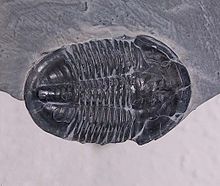

Fossils of trilobites appear in the Cambrian with the beginning of the (so far only provisionally named and delimited) 2nd series in the fossil record. The beginning of the 2nd series was more or less defined by this event. This means that their appearance is separated from the decisive events that mark the beginning of the Cambrian (the "Cambrian Explosion" ), around 13 million years ago, for the entire duration of the first series (now called Terreneuvium ) . The oldest trilobites are also the oldest unambiguous body finds of arthropods at all. In the fossil finds of the first series, known as the Small Shelly Fauna , remains of trilobites, or at least disarticulated segments or plates, would have been expected if these had been common or widespread during this period. Interestingly, the oldest trilobites occur roughly simultaneously in different regions of the earth (which correspond to the shallow seas of the continental plates of the disintegrating supercontinent Rodinia ), but with clearly related, but clearly different shapes. This vicarious distribution pattern shows that the actual origin of the trilobites must be older, since the spread to the other marine regions and the subsequent evolutionary divergence must have preceded it. This period of existence (known as the “ ghost range ”), which has only been tapped but cannot be proven by fossils , was estimated to be around 10 million years.
Trilobites are distinguished in the fossil record by their calcified back armor, which makes their fossilization much more likely. In the very few deposits in the world in which animals with soft tissue preservation from the corresponding epochs have been found (so-called conservatory deposits ), a whole zoo of other arthropods living at the same time has been found, some of which were extremely similar to the trilobites, only that her integument was not calcified. In the Chengjiang faunal community from China, which began near the first appearance of trilobites (some of the oldest from the genus Parabadiella were actually found here in the slightly older rock layers), arthropods are rich in species and individuals. Of the approximately 50 species, only five are trilobites, which make up barely 2% of the individuals. The uncalcified, trilobite-like groups are grouped together with the trilobites under the names Trilobitoidea, Trilobitomorpha or Lamellipedia (each of these names includes a somewhat different, but essentially comparable concept). All had a three-part body structure with a high middle section and two lateral extensions, a head shield made of several fused segments, one-branch (unirame) antennae and two-branch (birame) split legs, the inner branch (endopodit) of which was a walking leg and the outer branch (exopodit) of three segments existed, the first of which had a fringe of long, lamellar-like broadened bristles (controversial among some representatives / groups or not reliably detectable in the fossil material). Almost all of them also had a tail shield (pygidium). The trilobites differ from many representatives essentially only in two characteristics: the calcified dorsal cover and the upper (dorsal) lying eyes. Direct sister groups of the trilobites are z. B. the Helmetiida, the Naraoiidae , the Emucarididae (Nectopleura or Nektaspida) and the Tegopeltida, other groups such as the Xandarellida are a little more clearly distinguishable, but also very similar. The trilobites are ultimately only the best known and fossil best handed down group of an originally extensive relationship.
Interestingly, some features previously thought to be typical of trilobites also appear in other fossils from the same era. Many representatives of a group that are summarized as “great appendage arthropods” (or “megacheira”) according to one characteristic, a clearly segmented and heavily bristled first pair of legs, which probably served as a grasping organ for a predatory way of life, have a very similar three-lobed one Physique on. This group is not without controversy in terms of its relationship, but is usually considered to be the root group of arachnids . Another group of fossil arthropods with even more primitive features, such as Canadaspis and Fuxianhuia, was not far from this in physique; these animals are either considered to be representatives of the ancestral group of crustaceans or even the common ancestral group of all arthropods. Not only the uniform (repetitive) body structure with little differentiated legs, but numerous other features such as the three-lobed body structure, split leg, head and tail shield are thus proven to be the common legacy of the arthropods. They were found first among the trilobites, but not peculiar to this group, but are plesiomorphies inherited from their ancestors.
The relationship of the trilobites with the living (recent) arthropod orders of the arachnids and crustaceans has become an open question with these new findings. It depends critically on the interpretation of the homology of different body segments, especially the head and the very first pairs of extremities. Whether they form a group called Arachnata (or Arachnomorpha) together with the arachnids, which corresponds to the traditional view, or whether they are closer relatives of the crustaceans, depends above all on the interpretation of the position of the antenna segment in numerous fossil representatives. The antennae of the trilobites are clearly secondary; That is, they are extremities of the head segment that forms the second brain segment (Deutocerebrum), they were attached to the head lobe (hypostome). The antennae of the recent columbus (Onychophora), which are considered relatives of the arthropods, sit on the first head section (which forms the first brain section). The location of the antennae of numerous fossils is controversial. Depending on the interpretation, the established relationships then shift.
The later evolution of the trilobites brings numerous innovations in body structure and way of life, but an essentially unchanged morphology. The very latest fossil trilobites look very similar to the Cambrian representatives. The actual extinction had already been preceded by a number of "near-extinctions" in earlier waves of extinction, but these had been survived by a few species that were then able to differentiate themselves again. However, while numerous new species with different ways of life emerged in the Cambrian and Ordovician, in later epochs the surviving species could no longer develop into a comparable variety. Before their final extinction, the trilobites had been a species-poor relic group for almost 100 million years. Some well-adapted species were apparently able to survive in specific ecological niches , which were then lost in the events associated with the mass extinction at the Permian-Triassic border (it is estimated that 95% of all marine invertebrates living at the time were extinct at this event).
A survival of some representatives in inaccessible habitats like the deep sea seems to be almost impossible. It is brought up again and again by American creationists who hope to be able to sow doubts about the theory of evolution.
480 million year old fossils of the species Ampyx priscus from the lower Ordovician , which document a series formation of animals, were interpreted as the first evidence of swarm intelligence in living beings.
Trilobites as key fossils
Trilobites are among the most important key fossils in geological history. Their remains are used to determine the relative age of sedimentary rocks. This method is called biostratigraphy . Certain trilobite species occur only in short periods of time, so they are characteristic of the deposits of this time. In this way, the periods of formation of the sedimentary rocks can be determined. Trilobites are only fossilized in rocks of the ancient times (Paleozoic). The oldest trilobites that have been well preserved include the species of the genus Ellipsocephalus , a trilobite with an oval head. They are found all over the world.
Orders
Nine orders of the trilobite class are currently recognized:
- Agnostida : Very small and very small trilobites, mostly only a few millimeters long. Period: Lower Cambrian to Upper Ordovician.
- Redlichiida : Very old trilobites with many thorax segments ending in pleural spines. Period: Lower Cambrian to Middle Cambrian.
- Corynexochida : Elongated glabella (head armor) often with concave sides, usually well-defined eyes. Period: Lower Cambrian to Middle Devonian.
- Lichida : Mostly prickly trilobites. Period: Cambrian to Devonian.
- Phacopida : Diverse group with numerous manifestations. Period: Lower Ordovician to Upper Devonian.
- Proetida : Usually quite small trilobite forms. Period: Ordovician to Permian.
- Asaphida : Diverse group with numerous manifestations. Period: Middle / Upper Cambrian to Upper Ordovician / Lower Silurian.
- Harpetida : Main distinguishing feature: extremely large cephalonic border . Period: Upper Cambrian to Late Devonian.
- Ptychopariida : Large group with an immature classification. Period: Lower Cambrian to Upper Ordovician.
Find regions in Germany and Europe
- Perm : not reported in Germany; Europe: (?)
- Carboniferous : Rhenish Slate Mountains , Harz , Franconian Forest ; Carnic Alps , otherwise in Great Britain , France
- Devonian : Rhenish Slate Mountains, Harz, Eifel, especially the trilobite fields near Gees ; otherwise in the Carnic Alps, Great Britain, France, Barrandium , Poland
- Silurian : in bed load in Germany; otherwise in Sweden , Great Britain, Carnic Alps, Barrandium, Estonia
- Ordovician : in bed load in Germany, rarely in the Thuringian Forest and Franconian Forest; otherwise in Sweden, Norway, Bornholm , Estonia, Poland, Barrandium, France, Great Britain, Spain and Portugal
- Cambrian : in sediment in Germany, rarely in Lausitz and in the Franconian Forest; otherwise mainly in the Barrandium and in Sweden, Norway and Bornholm
Use as heraldic animals
Casings or shells of trilobites rarely appear in heraldry as heraldic animals ; their use suggests local sites.
Jince , Czech Republic
See also
literature
- Richard Fortey : Trilobites! Fossils tell the story of the earth. CH Beck, Munich 2002, ISBN 3-406-49592-3 .
- Harry Blackmore Whittington : The Burgess Shale. Yale University Press, New Haven et al. a. 1985, ISBN 0-300-03348-6 .
Individual evidence
- ↑ These do not always come from trilobites. See John-Paul Zonneveld, S. George Pemberton, Thomas DA Saunders, Ronald K. Pickerill: Large, Robust Cruziana from the Middle Triassic of Northeastern British Columbia: Ethologic, Biostratigraphic, and Paleobiologic Significance. In: Palaios. Volume 17, No. 5, 2002, pp. 435-448, doi : 10.1669 / 0883-1351 (2002) 017 <0435: LRCFTM> 2.0.CO; 2 .
- ↑ Johann Ernst Immanuel Walch : The natural history of petrifications. To explain the Knorrische Collection of Curiosities of Nature. Part 3. Felßecker, Nuremberg 1771.
- ↑ Robert Kihm, James St. John: Walchs trilobite research. In: Donald G. Mikulic, Ed Landing, Joanne Kluessendorf (eds.): Fabulous Fossils. 300 years of worldwide research on trilobites (= New York State Museum. Bulletin. 507). University of the State of New York - State Education Department, Albany NY 2007, ISBN 1-55557-235-9 , pp. 115-140.
- ↑ U. Lehmann: Paleontological dictionary. Unchanged reprint of the 4th edition, 278 pages, Springer, 2014.
- ↑ Overview in: Euan Clarkson , Riccardo Levi-Setti , Gabor Horvath: The eyes of trilobites: The oldest preserved visual system. In: Arthropod Structure & Development. Volume 35, No. 4, 2006, pp. 247-259, doi: 10.1016 / j.asd.2006.08.002 .
- ^ Richard A. Fortey : Pelagic trilobites as an example of deducing the life habits of extinct arthropods. In: Transactions of the Royal Society of Edinburgh. Earth Sciences. Volume 76, No. 2/3, 1985, pp. 219-230, doi: 10.1017 / S0263593300010452 .
- ↑ Lesley Cherns, James R. Wheeley, Lars Karis: Tunneling trilobites: Habitual infaunalism in an Ordovician carbonate seafloor. In: Geology. Volume 34, No. 8, 2006, pp. 657-660, doi: 10.1130 / G22560.1 .
- ↑ Richard A. Fortey, Robert M. Owens: Feeding habits in trilobites. In: Palaeontology. Volume 42, No. 3, 1999, pp. 429-465, doi: 10.1111 / 1475-4983.00080 .
- ↑ Mao-Yan Zhu, Jean Vannier, Heyo Van Iten, Yuan-Long Zhao: Direct Evidence for Predation on Trilobites in the Cambrian. In: Proceedings of the Royal Society of London. Series B: Biological Sciences. Volume 271, Supplement 5, 2004, pp. S277-S280, doi: 10.1098 / rsbl.2004.0194 .
- ^ J. Stuart Hollingsworth: The first trilobites in Laurentia and elsewhere. In: Isabel Rábano, Rodolfo Gozalo, Diego García-Bellido (eds.): Advances in Trilobite Research (= Cuadernos del Museo Geominero. 9). Instituto Geológico y Minero de España, Madrid 2008, ISBN 978-84-7840-759-0 , pp. 171-175.
- ↑ Jinling Yuan, Xuejian Zhu, Jihpei Lin, Maoyan Zhu: Tentative correlation of Cambrian Series 2 between South China and other continents. In: Bulletin of Geosciences. Volume 86, No. 3, 2011, pp. 397-404, doi: 10.3140 / bull.geosci.1274 .
- ^ Bruce S. Lieberman : Taking the Pulse of the Cambrian Radiation. In: Integrative and Comparative Biology. Volume 43, No. 1, 2003, pp. 229-237, doi: 10.1093 / icb / 43.1.229 .
- ↑ Xianguang Hou, Jan Bergström : The Chengjiang fauna - the oldest preserved animal community. In: Paleontological Research. Volume 7, No. 1, 2003, pp. 55-70, doi: 10.2517 / prpsj.7.55 .
- ↑ James W. Hagadorn: Chengjiang. Early Record of the Cambrian Explosion. In: David H. Bottjer, Walter Etter, James W. Hagadorn, Carol M. Tang (Eds.): Exceptional Fossil Preservation. A Unique View on the Evolution of Marine Life. Columbia University Press, New York NY 2002, ISBN 0-231-10255-0 , pp. 35-60, ( digital copy (PDF; 6.55 MB) ).
- ^ Jan Bergström, Xian-Guang Hou: Arthropod origins. In: Bulletin of Geosciences. Volume 78, No. 4, 2003, pp. 323-334, ( digital version (PDF; 270.32 KB) ).
- ↑ John R. Paterson, Gregory D. Edgecombe , Diego C. Garcia-Bellido, James B. Jago, James G. Gehring: Nektaspid arthropods from the Lower Cambrian Emu Bay Shale deposit, South Australia, with a reassessment of lamellipedian relationships. In: Palaeontology. Volume 53, 2010, pp. 377-402, doi: 10.1111 / j.1475-4983.2010.00932.x .
- ↑ Overview in: Nigel C. Hughes: The Evolution of Trilobite Body Patterning. In: Annual Review of Earth and Planetary Sciences. Volume 35, 2007, pp. 401-434, doi: 10.1146 / annurev.earth.35.031306.140258 .
- ↑ Graham E. Budd, Maximilian J. Telford: The origin and evolution of arthropods. In: Nature . Volume 457, No. 7231, 2009, pp. 812-817, doi: 10.1038 / nature07890 .
- ↑ Gerhard Scholtz. Gregory D. Edgecombe: The evolution of arthropod heads: reconciling morphological, developmental and palaeontological evidence. In: Development Genes and Evolution. Volume 216, No. 7/8, 2006 = Special Issue: Development and Phylogeny of Arthropods. Pp. 395-415, doi: 10.1007 / s00427-006-0085-4 .
- ↑ Linda A. Ritterbush: A History of Trilobites as "Living Fossils". In: Perspectives on Science and Christian Faith. Volume 56, No. 2, 2004, pp. 131-134, ( digital version (PDF; 330.86 KB) ).
- ↑ Behavioral biology: Fossils prove swarm intelligence as early as 480 million years ago. Retrieved October 18, 2019 (article on the English publication: https://doi.org/10.1038/s41598-019-51012-3 ).
Web links
- TRILOBITA.DE - An introduction to the world of primeval sea creatures
- Trilobite fossil atlas
- www.trilobites.info - English language information site
- WTA - Excellent website about the trilobites of the USA and Canada, with detailed lists of species with illustrations
- TRILOBITEN.DE - The German site about trilobites with detailed articles, pictures and an attached forum.
